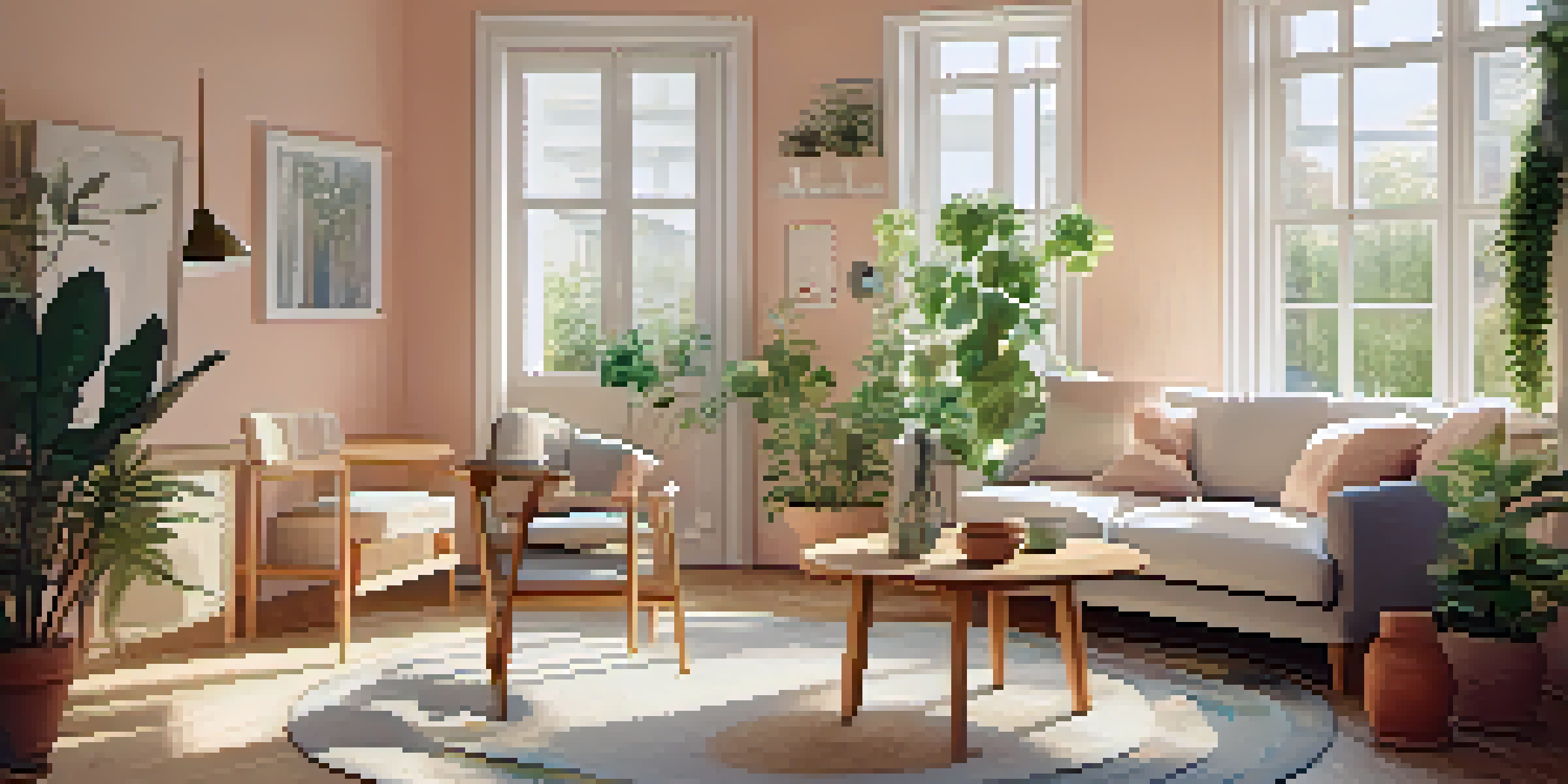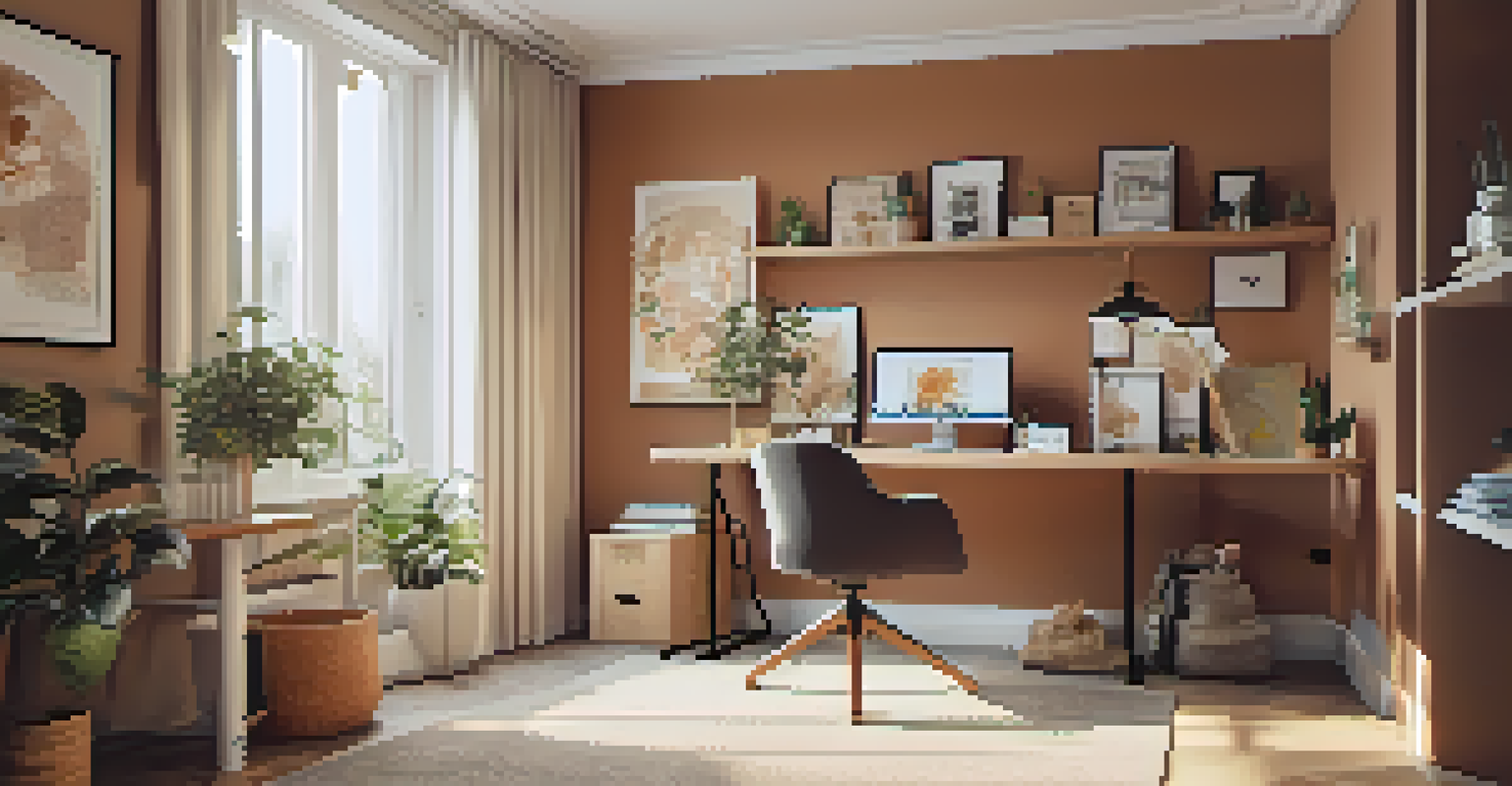Designing Small Spaces with Movable Furniture for Flexibility

Understanding the Benefits of Movable Furniture in Small Spaces
Movable furniture is a game-changer for small spaces, offering versatility and functionality. By incorporating pieces that can be easily rearranged, you can quickly adapt your environment to fit different needs, whether you're hosting a gathering or enjoying a quiet evening alone. This flexibility not only maximizes your space but also allows for a more dynamic living experience.
The best way to predict the future is to create it.
For instance, consider using foldable tables that can expand when needed and compact when not in use. This way, you can maintain an open area for daily activities and transform it into a social hub when friends come over. The ability to switch between setups can make even the tiniest apartment feel spacious and inviting.
Moreover, movable furniture encourages creative problem-solving. You can experiment with different layouts to find what works best for you, making the most out of every square foot. This adaptability is essential in today’s fast-paced lifestyle, where our needs can change from one moment to the next.
Choosing the Right Movable Furniture for Your Space
When selecting movable furniture, it’s important to prioritize pieces that are both functional and stylish. Look for items that serve multiple purposes, like ottomans that can double as seating or storage. This way, you’re not just filling your space with furniture, but with smart solutions that enhance your lifestyle.

Consider the scale of the furniture in relation to your space. Oversized pieces can quickly overwhelm a small room, making it feel cramped. Instead, opt for lightweight options that are easy to move around, allowing for a seamless flow between different areas of your home.
Versatile Movable Furniture Benefits
Movable furniture enhances small spaces by providing flexibility and functionality, allowing for quick adaptations to various needs.
Additionally, materials matter. Lightweight materials like aluminum or softwoods can make it easier to shift furniture around as needed. By choosing the right pieces, you can create a functional, aesthetically pleasing environment that reflects your personal style while maximizing space.
Creative Layout Ideas for Movable Furniture Arrangements
Getting creative with furniture arrangements can transform your small space dramatically. Consider a layout that encourages movement and interaction, such as a circular seating arrangement that allows everyone to engage easily. This not only makes the space feel larger but also fosters a sense of community among those using it.
Small spaces can be beautiful, functional, and welcoming if you embrace flexibility and creativity.
Another idea is to use movable partitions or shelving units to create distinct zones within a single room. This can help define areas for work, relaxation, or dining, while still allowing the flexibility to change things up as needed. Think of it as creating little nooks that serve different purposes without the need for permanent walls.
Remember to keep flow in mind; make sure there’s enough room to navigate comfortably between furniture pieces. By experimenting with different layouts, you can discover what feels right and best utilizes your available space.
Incorporating Multi-Functional Pieces in Your Design
Multi-functional furniture is a must-have for small spaces. Items like sofa beds or coffee tables with built-in storage can serve double duty, helping you save space while providing essential functions. This approach not only maximizes utility but also minimizes clutter, making your home feel more organized.
Think about how often you use certain pieces of furniture and choose ones that can adapt to your needs. For instance, a dining table that can be adjusted in height can serve as both a workspace and a dining area, making it incredibly versatile. This way, you’re investing in furniture that truly works for you.
Choose Multi-Functional Pieces
Selecting furniture that serves multiple purposes helps maximize utility and minimizes clutter in compact living environments.
Additionally, don’t shy away from innovative designs. Many companies now offer modular furniture that can be reconfigured based on your requirements. This level of adaptability is perfect for anyone looking to optimize their living space without sacrificing style.
Maximizing Vertical Space with Movable Solutions
In smaller homes, vertical space is often underutilized. By incorporating movable shelving or wall-mounted units, you can take advantage of every inch without overwhelming the floor. This clever use of space can also help keep necessary items accessible and organized, enhancing overall functionality.
Consider floating shelves that can be adjusted as needed. They provide a stylish way to display decor while freeing up floor area for larger pieces. Plus, they can be easily repositioned if your design preferences change or if you need to create more room.
Utilizing vertical space not only helps maintain an open feel but also adds a unique dimension to your design. It invites the eye upward, making your space appear larger and more dynamic, which is particularly beneficial in compact living environments.
Choosing the Right Color Palette for Small Spaces
Color plays a crucial role in how a small space feels. Lighter shades tend to open up a room, making it feel airy and expansive. Consider using a cohesive color palette throughout your movable furniture and decor to create a harmonious environment that visually connects different areas.
You can also use pops of color strategically in smaller accents, like cushions or wall art, to add personality without overwhelming the space. This approach allows for flexibility in design while maintaining a sense of unity. Plus, when you decide to change the look, swapping out these smaller pieces is much easier than repainting or buying new furniture.
Utilize Vertical Space Effectively
Incorporating vertical solutions like shelving can optimize space and create a more organized and dynamic living area.
Don’t forget about texture, too! Mixing different materials can add depth to your design. A blend of soft fabrics, smooth surfaces, and natural elements can elevate the overall aesthetic while keeping the space feeling inviting and cozy.
Maintaining a Flexible Mindset in Small Space Design
Designing small spaces with movable furniture requires a flexible mindset. Embrace the idea that your space can evolve over time; what works now might change as your needs or preferences shift. This adaptability is key to creating a home that truly reflects who you are and how you live.
Encourage yourself to regularly reassess your furniture arrangement and consider how you can improve functionality. Sometimes, simply moving a piece to a different spot can make a world of difference in how you interact with your space. Don’t be afraid to experiment and try new layouts or combinations.

Finally, remember that the journey of designing your small space is ongoing. As you add new items or shift existing ones, your environment will constantly evolve, making it a unique reflection of your lifestyle. Embrace this change, and your home will always feel fresh and accommodating.